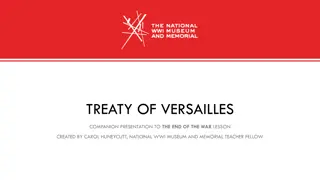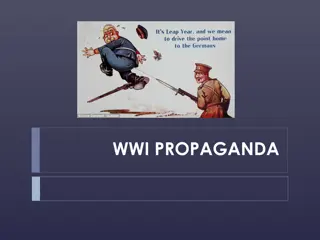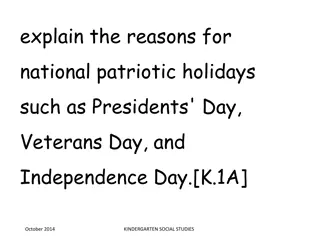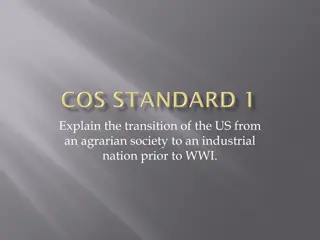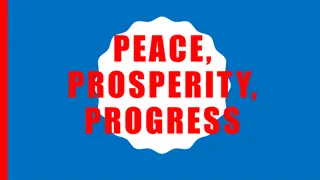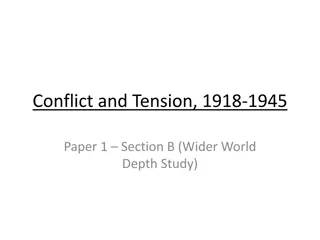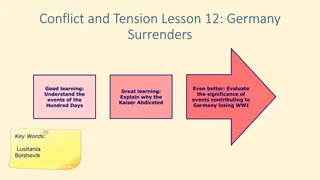America's Patriotic Victory Gardens During WWI and WWII
Victory gardens became popular during WWI and WWII due to food shortages in the United States caused by the need to send produce overseas for the troops. The National War Commission encouraged Americans to plant their own gardens, leading to a movement that promoted self-sufficiency and community collaboration. Propaganda posters and pamphlets spread awareness and provided guidance on gardening, resulting in millions of new garden plots and canned food production. The program, known as the war garden movement, enlisted civilians of all ages to contribute to the war effort.
Download Presentation

Please find below an Image/Link to download the presentation.
The content on the website is provided AS IS for your information and personal use only. It may not be sold, licensed, or shared on other websites without obtaining consent from the author.If you encounter any issues during the download, it is possible that the publisher has removed the file from their server.
You are allowed to download the files provided on this website for personal or commercial use, subject to the condition that they are used lawfully. All files are the property of their respective owners.
The content on the website is provided AS IS for your information and personal use only. It may not be sold, licensed, or shared on other websites without obtaining consent from the author.
E N D
Presentation Transcript
VICTORY GARDENS America s Patriotic Victory Gardens May 29, 2014 By Laura Schumm http://www.history.com/news/hungry-history/americas-patriotic-victory-gardens
VICTORY GARDENS BECAME POPULAR DURING WWI AND WWII. BECAUSE PRODUCE NEEDED TO BE SENT OVERSEAS FOR THE TROOPS, THERE WAS A FOOD SHORTAGE IN THE UNITED STATES. TO HELP WITH THE FOOD SHORTAGE, THE GOVERNMENT TURNED TO CIVILIANS AND ENCOURAGED THEM TO GROW THEIR OWN FRUITS AND VEGETABLES. THIS BEGAN A MOVEMENT THAT ENCOURAGED CITIZENS TO WORK TOGETHER FOR A GREATER CAUSE. MANY POSTERS AND PAMPHLETS WERE DISTRIBUTED TO HELP SPREAD AWARENESS OF THE PROGRAM. Read the article to determine what victory gardens were and why they are important to learn about today.
PARAGRAPH 1 What did the National War Commission encourage Americans to do? Why were Americans asked to plant their own gardens? Define emerge, burden, export, idle Emerge- Burden- Export- Idle- 1. During World War I, a severe food crisis emerged in Europe as farmers were recruited into military service and farms were transformed into battlefields. As a result, the burden of feeding millions of starving people fell to the United States. In March of 1917 just weeks before the United States entered the war Charles Lathrop Pack organized the National War Garden Commission to encourage Americans to contribute to the war effort by planting, fertilizing, harvesting and storing their own fruits and vegetables so that more food could be exported to our allies. Citizens were urged to utilize all idle land that was not already engaged in agricultural production including school and company grounds, parks, backyards or any available vacant lots. 2. 3.
PARAGRAPH 2 Promoted through propaganda posters advocating that civilians Sow the seeds of victory by planting their own vegetables, the war garden movement (as it was originally known) was spread by word of mouth through numerous women s clubs, civic associations and chambers of commerce, which actively encouraged participation in the campaign. Amateur gardeners were provided with instruction pamphlets on how, when and where to sow, and were offered suggestions as to the best crops to plant, along with tips on preventing disease and insect infestations. The endeavor was so well received that the government turned its attention to distributing canning and drying manuals to help people preserve their surplus crops. In addition to the appeal to men and women, the federal Bureau of Education initiated a U.S. School Garden Army (USSGA) to mobilize children to enlist as soldiers of the soil. As a result of these combined efforts, 3 million new garden plots were planted in 1917 and more than 5.2 million were cultivated in 1918, which generated an estimated 1.45 million quarts of canned fruits and vegetables. By the end of World War I, the campaign promoting home gardens which by then were referred to as victory gardens had dropped off, but many people continued to maintain them. 1. How did people learn about the idea of the war garden? 2. What type of information did the instruction pamphlets provide to gardeners? 3. Based on the information you read in paragraph 2, do you think the program was popular among Americans, and why or why not? 4. Define propaganda, advocate, amateur, cultivate, maintain Propoganda Advocate Amateur Cultivate Maintain
1. Based on the information in paragraph 3, where could people plant a victory garden? PARAGRAPH 3 2. define emerge, divert, munition, ration Shortly after the United States was drawn into the Second World War, victory gardens began to reemerge. Once again, commercial crops were diverted to the military overseas while transportation was redirected towards moving troops and munitions instead of food. With the introduction of food rationing in the United States in the spring of 1942, Americans had an even greater incentive to grow their own fruits and vegetables in whichever locations they could find: small flower boxes, apartment rooftops, backyards or deserted lots of any size. Eleanor Roosevelt even planted a victory garden on the White House lawn. Emerge- Divert- Munition- Ration-
PARAGRAPH 4 In your own words, explain the various reasons the victory garden program was successful? Define morale, arduous, renaissance, sufficient 1. 2. Throughout both world wars, the Victory Garden campaign served as a successful means of boosting morale, expressing patriotism, safeguarding against food shortages on the home front, and easing the burden on the commercial farmers working arduously to feed troops and civilians overseas. In 1942, roughly 15 million families planted victory gardens; by 1944, an estimated 20 million victory gardens produced roughly 8 million tons of food which was the equivalent of more than 40 percent of all the fresh fruits and vegetables consumed in the United States. Although the government s promotion of victory gardens ended with the war, a renaissance movement has sprouted up in recent years in support of self-sufficiency and eating seasonally to improve health through local, organic farming and sustainable agriculture.
VICTORY GARDEN SEEDS 1943- Men and Woman would buy seeds to use in planting their own victory garden. Watch the following interview. Then answer, why was the program good for young people? http://www.livinghistoryfarm.org/fa rminginthe40s/movies/holthus_crop s_02.html



